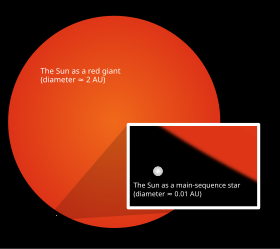
A red giant is a luminous giant star of low or intermediate mass (roughly 0.5–10 solar masses) in a late phase of stellar evolution. The outer atmosphere is inflated and tenuous, making the radius immense and the surface temperature low, somewhere from 5,000 K and lower. The appearance of the red giant is from yellow orange to red, including the spectral types K and M, but also class S stars and most carbon stars.
The most common red giants are the so-called red giant branch stars (RGB stars) whose shells are still fusing hydrogen into helium, while the core is inactive helium. Another case of red giants are the asymptotic giant branch stars (AGB) that produce carbon from helium by the triple-alpha process. To the AGB stars belong the carbon stars of type C-N and late C-R. Prominent bright red giants in the night sky include Aldebaran (Alpha Tauri), Arcturus (Alpha Bootis), and Gamma Crucis (Gacrux), while the even larger Antares (Alpha Scorpii) and Betelgeuse (Alpha Orionis) are red supergiants.
Red giants are stars that have exhausted the supply of hydrogen in their cores and switched to thermonuclear fusion of hydrogen in a shell surrounding the core. They have radii tens to hundreds of times larger than that of the Sun. However, their outer envelope is lower in temperature, giving them an orange hue. Despite the lower energy density of their envelope, red giants are many times more luminous than the Sun because of their large size. Main sequence stars of spectral types A through K are believed to evolve into red giants. The Sun is predicted to become a red giant in approximately 7.5 billion years. It is calculated that the Sun will become sufficiently large to engulf the current orbits of the Solar System's inner planets, up to Earth.